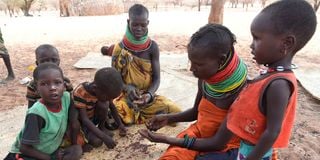Hungry Turkana families forced to share scanty food rations

Getting a meal has never been an easy proposition in hot and dusty Turkana, but a prolonged dry spell over the past couple of years has made matters so much worse.
In remote Konyipad village in Loima Constituency, pastoralists who depend on their livestock for a living have been reduced to beggars after their herds were wiped out by the drought.
It is midday, and Ms Hellen Lochodo, a mother of six, and her co-wife Agnes Kurichon, who has four children, crouch with their starving progeny under a gnarled acacia tree, sorting beans from chaff.
This will be their first meal in several days as they have been surviving on measly portions of doum palm fruits sourced from Turkwel River.
Ms Lochodo says the beans were borrowed from a friend who lives in Kaakilala village and who had received relief food from the county government. Sharing meals, she says, is the only way people can stay alive.
“It will not be enough but I will share with all our 10 children, my co-wife, our husband and our grandmother in small quantities,” she says.
Hunger and disease are hardly strange bedfellows. Wherever hunger walks, disease shadows closely. Sickly 85-year-old Arupe Echekan has lived long enough to see her fair share of suffering, but the ongoing drought ranks up there among the worst.
“This is the worst drought I have experienced since I was born. Our livestock have died, the surviving ones are emaciated and cannot be relied on for milk or even blood,” she says.
According to Turkana Peace and Development Initiative Founder Dr Jane Apetet, the devastating effects of climate change has negatively affected the livelihoods of more than 800,000 people in the county.
“Extreme weather like drought and floods has seen a huge number of children facing severe malnutrition, forcing most to drop out of school. The elderly and people living with disability are hardest hit,” she says.
With the major economic activity being livestock rearing at 67 per cent, she says, the drought has exposed residents to extreme poverty. Dr Apetet adds that there is need to devise a sustainable approach towards making the county food secure.
“According to the Turkana County Integrated Development Plan 2018-2022, there’re about 2.5 million hectares of arable land that can provide a solution to perennial food scarcity. The current 51 irrigation schemes are faced with challenges such as lack of skilled labour, soil acidity, insecurity, water shortage and lack of technical knowledge among farmers,” Dr Apetet says.
She calls for investment in climate-smart agriculture, encouraging farmers to plant drought resistant crops, enhanced agricultural extension services and increased funding to farmers to enable them to get certified seeds and other farm inputs.
To address the challenge of water scarcity, there is a need to sink more solar-powered boreholes, she adds. Turkana County Commissioner Jacob Ouma says the National Drought Management Authority (NDMA) has provided pastoralists with animal feeds worth Sh25 million.
“Last month, we distributed 8,400 90-kilo sacks of animal feeds,” he says, adding that NDMA also supplied diesel to power water pumps in 10 boreholes and also carried out repairs and maintenance services at an extra cost of Sh5 million.
Governor Jeremiah Lomorukai recently assured residents that the county was in the process of procuring additional relief food. His administration, Mr Lomorukai pledged, would increase allocations to the County Emergency Fund to cushion residents against the drought.
“We will engage with members of the county assembly to allocate enough funds for emergency response. We have witnessed delays in the supply of relief food because the prices of cereals in the market are high due to shortages. Distribution resumes once the new consignment of relief food hits the stores,” he said.
The county boss informed residents of plans to join hands with development partners and humanitarian organisations in efforts to boost the county’s emergency response capacity.






